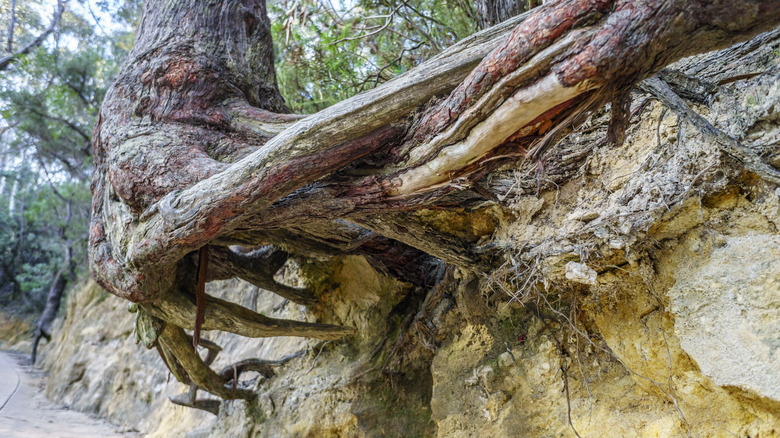Four Types Of Physical Weathering
Physical weathering, also known as mechanical weather, is the process of rocks and minerals on Earth's surface breaking down or dissolving as a result of water, ice, salt, plants, animals or changes in temperature. Physical weathering does not change the chemical composition of the rock, just cracks and crumbles it into smaller pieces. After a rock has weathered, erosion occurs, transporting bits and pieces away. Finally a deposition process deposits the rock particles in a new place.
Weathering From Water
Weathering From Water
Water can weather rocks in a variety of ways. Moving water can lift and carry rocks from the bottom of a river or stream. When the rocks return to the ground under water, they can hit other rocks and break apart. Water can also weather a rock by affecting the material around it. For instance, clay that surrounds a rock can absorb water, swell and then push against the rock, causing it to break. Saltwater can cause another kind of weathering after it evaporates. When saltwater seeps into rock pores and then evaporates, crystals are left behind. The crystals grow and put pressure on the rock, which eventually causes it to break apart. Saltwater weathering is common along coastlines.
Weathering From Ice
Weathering From Ice
When water sinks into cracks in a rock and the temperature drops low enough, the water freezes into ice. The ice expands and forms wedges in the rock that can split the rock into smaller fragments. Ice wedging usually occurs after water repeatedly freezes and melts inside small rock crevices over time. You can see the result of this type of weathering on street sidewalks in the winter. Ice wedges often cause potholes in roads and streets. Ice forms in the cracks of streets, expands and pushes on the surrounding rock or pavement, widening the cracks until they split and break apart.
Weathering From Plants
Weathering From Plants
Plants can cause physical weathering as their roots grow. Seeds of plants or trees can grow inside rock cracks where soil has collected. The roots then put pressure on the cracks, making them wider and eventually splitting the rock. Even small plants can cause this kind of weathering over time.
Weathering From Animals
Weathering From Animals
Animals that burrow underground, such as moles, gophers or even ants, can also cause physical weathering by loosening and breaking apart rocks. Dens and tunnels are signs of this type of weathering. Other animals dig and trample rock on the Earth's surface, causing rock to slowly crumble apart. This process exposes new parts of the rock to the elements, making them susceptible to other types of weathering, such as chemical weathering.
Cite This Article
MLA
Pancare, Rachel. "Four Types Of Physical Weathering" sciencing.com, https://www.sciencing.com/four-types-physical-weathering-6456598/. 20 April 2018.
APA
Pancare, Rachel. (2018, April 20). Four Types Of Physical Weathering. sciencing.com. Retrieved from https://www.sciencing.com/four-types-physical-weathering-6456598/
Chicago
Pancare, Rachel. Four Types Of Physical Weathering last modified August 30, 2022. https://www.sciencing.com/four-types-physical-weathering-6456598/
